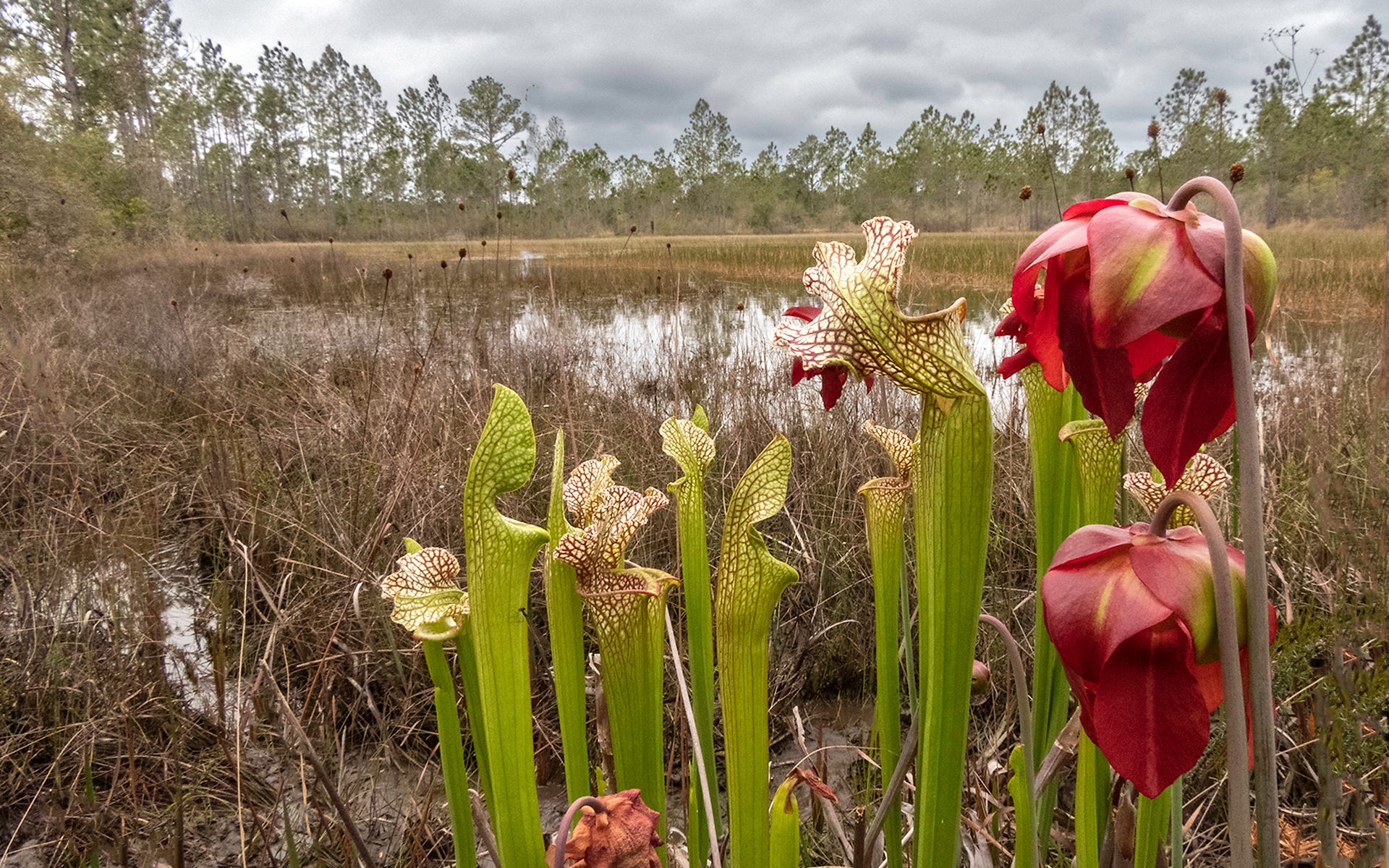Blood, Death, Deception and a Defiant Moth
An audacious moth and a killer plant act out the struggle for existence in a chamber of death and resurrection.
Housekeeping: If you happen to find yourself in Vermont on April 7, join me and friends in Montpelier for readings, poetry, music and reflections at our event called “Natural Selections.” Details are below (after the blood, death and deception).
PLANTS AND INSECTS usually get along well enough — except when they kill and consume one another. So go the pitcher plants, ruthless in form, function and deadly seductions.
The crimson veins of White Pitcher Plant (Sarracenia leucophylla) presumably help to beckon mosquitoes and other insects seeking flesh and blood. Once they take the bait, the prey fall into a leaf chamber that holds a toxic bath of enzymes and bacteria. Death is by drowning. Then comes decomposition. The plant appropriates the remains.
That is unless the insect is a rebel that not only cheats death but counter-attacks the killer plant.
Having met up with spring on my road trip to the American Southeast, I’m now heading north toward home in Vermont (where I will greet spring yet again). It is hard to turn my back on this arresting pitcher plant species, one of about 10 in the genus Sarracenia in North America. This one stands knee-high and lives largely in wetlands of the Florida Panhandle and nearby Alabama (with introduced populations scattered around the United States).
White Pitcher Plant is also globally imperiled; threats include habitat destruction, often for housing or agriculture, as well as herbicide use, invasive species and poaching. And yet one predator of sorts on this plant is entirely natural: Pitcher Plant Mining Moth (Exyra semicrocea). Yellow and black, and about the size of your fingertip, this moth comes and goes about the pitcher plant as it pleases, using the death chamber as a crash pad.
And if that isn’t audacious enough, after mating the female moth lays one or more eggs on the pitcher wall. From each egg hatches a caterpillar, which proceeds to dine on its host.
The caterpillar eats the pitcher — a herbivore eats a carnivore.
Once it has consumed or damaged most of the pitcher (which is a modified leaf), the caterpillar crawls into another pitcher on the plant. It cuts a small drain hole in the chamber, presumably to prevent a rising tide of toxic soup. Then it anchors itself to the pitcher wall, forms a cocoon where it pupates over the winter, and eventually emerges the following year to fly free as an adult.
Among nearly everything in nature we often find even more drama than meets the eye. Even in a chamber of death there can be defiance and life.


Postscripts and References
Find more lovely pictures of the moths and their caterpillars on Pitcher Plant Mining Moth’s iNaturalist page.
An excellent resource on the moth is “Life History Aspects of Exyra semicrocea (Pitcher Plant Moth) (Lepidoptera: Noctuidae)” by Jessica D. Stephens and Debbie R. Folkerts, published in Southeastern Naturalist 11(1):111–126.
For many of us in eastern North America and parts of Canada, Purple Pitcher Plant (Sarracenia purpurea), presumably luring prey with its fleshy coloring, is our only or dominant species. Its related moth visitor is Epauletted Pitcher Plant Moth (Exyra fax).
White Pitcher Plant’s IUCN Red List page. Other common names for this species include White-topped Pitcher Plant, White Trumpet Pitcher Plant, Crimson Pitcher Plant.
My Poem City Readings on April 7 in Vermont
NATURAL SELECTIONS is the poetry of Scudder Parker, the music of D. Davis and Ruth Einstein, and short readings by me, Bryan Pfeiffer. This evening of ideas, prose and music is a fundraiser for the North Branch Nature Center, a small preserve on a grand mission to connect more of us to nature and its many rewards. The suggested donation ranges from $15-30. This is also an event in Montpelier's Poem City 2023 celebration.
Scudder's award-winning book of poetry, Safe As Lightning, was published in 2020 after his career as a minister, a Vermont state senator and energy policy consultant. D. Davis (guitar) and Ruth (violin) blend passion and virtuosity into music that calms and reflects. And I'll be reading short dispatches on nature and meaning, including news from this trip to the Southeast.






Bryan, it is not the buckthorn per se, it is the tick issue that is keeping us out. We did get treated gaiters last summer, socks in shoes, etc.. You must have your own strategies.
Joe
Great observation, fine writing and excellent photos too - One of my favourite substacks